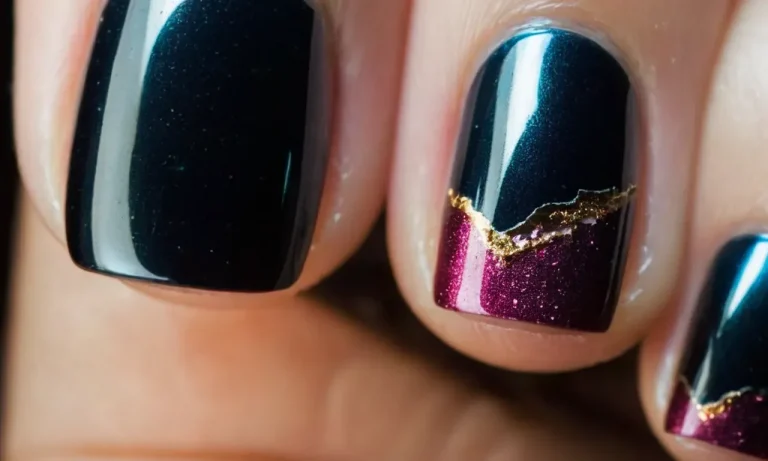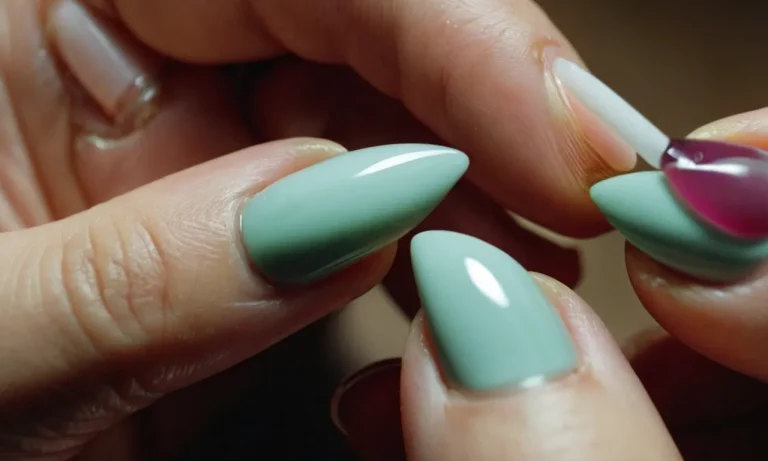Feet With Long Toenails: Causes, Risks, And Treatment
Having long toenails that extend beyond the tip of your toe can be unsightly and uncomfortable. If left untreated, it can even lead to more serious foot problems. In this comprehensive guide, we’ll explore what causes toenails to grow long, the risks associated with long nails, and the various treatment options available.
If you’re short on time, here’s a quick answer: Long toenails are often caused by poor nail care, fungal infections, or medical conditions that affect nail growth. The risks include ingrown toenails, walking difficulties, and infections.
Treatment options include trimming nails, prescription medications, surgery, and preventive care.
Causes of Long Toenails
Poor Foot Hygiene
Neglecting proper foot hygiene can lead to excessive toenail growth over time. When toenails are not trimmed regularly, they can grow longer and curve over the tips of the toes. Layers of dirt, debris, and fungi can build up underneath untrimmed nails, causing thicker and distorted nails.
Maintaining a consistent nail care routine by washing the feet daily, drying properly between the toes, trimming nails straight across every few weeks, and wearing clean socks and shoes can help prevent overly long toenails.
Fungal Infections
Toenail fungus, medically known as onychomycosis, is a common infection causing nearly 50% of long toenail issues in adults. It occurs when tiny organisms called dermatophytes grow under and into the nail bed.
As the fungus spreads deeper, the infected part of the nail can thicken, discolor, crumble, and detach from the nail bed, allowing debris to accumulate underneath. If ignored over time, the end of the nail can overgrow significantly.
Using public showers, sweating in tight shoes, walking barefoot in damp areas, and having a weakened immune system can increase susceptibility to nail fungus.
Treating the fungal infection requires seeing a podiatrist or dermatologist to determine the type of fungus and using prescription oral or topical medications. Successfully getting rid of the fungus can help prevent further lengthening and distortion of the infected toenail.
Medical Conditions
Certain health conditions can also contribute to abnormal toenail growth if the problems are left unmanaged over long periods:
- Diabetes often causes slower healing and poor circulation in the feet, increasing risks of fungal nail infections that distort nail growth.
- Psoriasis can prompt pitting, crumbling and overgrowth of toenails.
- Peripheral vascular disease reduces blood flow to the feet, leading to slower nail growth.
- Arthritis limits mobility, making toenail care difficult.
Consulting a doctor to properly manage the underlying condition can help prevent associated toenail abnormalities. The doctor may refer to a podiatrist for specialized foot care to keep nails well-trimmed.
Risks and Complications
Allowing toenails to grow too long can lead to several problems. While they may seem harmless, long toenails put you at risk for issues like ingrown toenails, discomfort, walking difficulties, and even infections.
Ingrown Toenails
An ingrown toenail occurs when the nail grows into the skin on one or both sides of the toe. This often happens when toenails are cut too short or shoes put extra pressure on the sides of the nails, causing them to dig into the skin. Ingrown toenails can be quite painful, red, and swollen.
Those with exceptionally long toenails have an increased risk of developing ingrown toenails. As the nail grows longer, the pressure builds and makes it easier for the sharp edges to pierce the skin and become embedded.
Discomfort and Pain
In addition to ingrown toenails, long nails can cause general discomfort and pain in the feet. As they extend past the tip of the toe, they are prone to catching on socks, bedding, and inside shoes. This can lead to the nails bending, cracking, or even breaking.
Broken nails with sharp edges pinch and stab the toes with every step. Even without breaking, the pressure of long nails rubbing inside shoes can be quite bothersome. The tension leads to toe pain that makes walking normally challenging.
Walking Difficulties
Long, uneven toenails alter your gait and make walking difficult. As they catch on surfaces and collide with shoe fronts, you end up walking more gingerly to accommodate the discomfort. This leads to joint pain, instability, limping, and strain.
Over time, adapting your gait to painful long toenails can contribute to problems in the knees, hips, and lower back. It may also throw off your balance and coordination, increasing your risk of falls and injury.
Bacterial and Fungal Infections
Finally, untrimmed toenails are prone to transmitting or harboring infections. Bacteria and nail fungus tend to accumulate under and around long nails. Fungal infections, in particular, thrive in the moist environment.
As you walk around, the organisms under the nails can spread to other areas of your feet or get tracked around your home. In people with weakened immune systems, the bacteria and fungi can even enter the bloodstream and lead to serious secondary infections.
Keeping toenails neatly trimmed helps avoid disease transmission and contamination of wounds or ulcers on your feet and toes.
When to See a Doctor
Ingrown Toenail
An ingrown toenail can be quite painful and lead to infection, so it’s important to see a podiatrist if you have one. Signs that you should make an appointment include:
- Redness, swelling, and tenderness around the toenail
- Pus draining from the nail
- Difficulty wearing shoes due to pain
- The nail is growing into the skin, causing pain and irritation
A podiatrist can trim the nail and relieve the pressure. They may also prescribe antibiotics if an infection is present. Ignoring an ingrown nail could lead to a severe infection requiring surgical removal of the nail.
Discolored or Thickened Nails
Nails that are discolored, brittle, or thick can indicate a fungal infection or inflammatory condition like psoriasis. It’s a good idea to see a dermatologist if you notice:
- Yellow, brown, or black discoloration in the nails
- White spots or streaks on the nails
- The nails becoming thick or brittle
- Nails separating from the nail bed
A dermatologist can examine the nails and determine if medication is needed to clear up a fungal or inflammatory condition. Leaving these conditions untreated can lead to painful, unsightly nails.
Foul Smell
A foul smell coming from the toes or feet is never normal. This can indicate a bacterial infection that requires medical treatment. See a doctor right away if you notice:
- An unpleasant or strong odor coming from the feet
- Discharge that has an offensive smell
- Redness or swelling around an infected toenail
The smell is typically caused by a bacterial infection, which can spread quickly without antibiotic treatment. This can become a serious issue if the infection spreads to the bones.
Bleeding or Pus
Bleeding or pus around the toenails should always be examined by a podiatrist. Signs to watch for include:
- Bleeding when trimming the nails
- Red streaks extending from the nail
- Pus oozing from the nails or cuticles
- Discharge that smells offensive
These symptoms indicate an infection is present. A minor cuticle infection can quickly spread to the nail bed or bone if untreated. See a podiatrist promptly for antibiotics or antifungal medication before the infection worsens.
Treatment Options
Trimming and Filing
Trimming and filing overgrown toenails is often the first line of treatment. Using toenail clippers or scissors, carefully cut the nail straight across to avoid ingrown edges. File down sharp edges gently with an emery board. This helps prevent snagging and additional swelling.
For tough thickened nails, a podiatrist may use specialized instruments.
Prescription Medications
If an infection is present, antifungal creams or oral medications may be prescribed. Topical antifungal lacquers like ciclopirox can help clear nail fungus. Oral terbinafine or itraconazole may be prescribed for stubborn fungal infections.
These help stop the spread while the infected part of the nail grows out. Antibiotics may also be used short-term if the skin is broken and a bacterial infection develops.
Surgery
In severe cases, surgical removal of part or all of the toenail may be recommended. This is known as a partial or total nail avulsion. The offending portion of nail is numbed with local anesthetic and detached from the nail bed. Chemical cauterization helps prevent recurrence.
Another option is to surgically excise the sides of the nail if they are ingrown. Recurrence is still possible, so diligent follow-up care is essential.
Preventive Care
Practicing good foot hygiene and nail care can help prevent long thickened toenails. Trim nails straight across monthly. Avoid rounded edges which encourage ingrowth. Disinfect nail tools before reusing. Wear properly fitted shoes and rotate pairs regularly. Treat athlete’s foot promptly.
Moisturize nails and cuticles with oil. See a podiatrist at the first sign of nail changes or discomfort. Those with chronic medical conditions like diabetes should have professional foot exams annually.
Conclusion
Long toenails that extend well beyond the tip of the toe can lead to discomfort, pain, and complications if left untreated. While some causes like fungal infections may require medical treatment, regularly inspecting and trimming your nails can help prevent excessive growth.
If you are experiencing any signs of nail problems, see your doctor for professional care. With proper foot hygiene and care, you can keep your toenails a healthy length.







